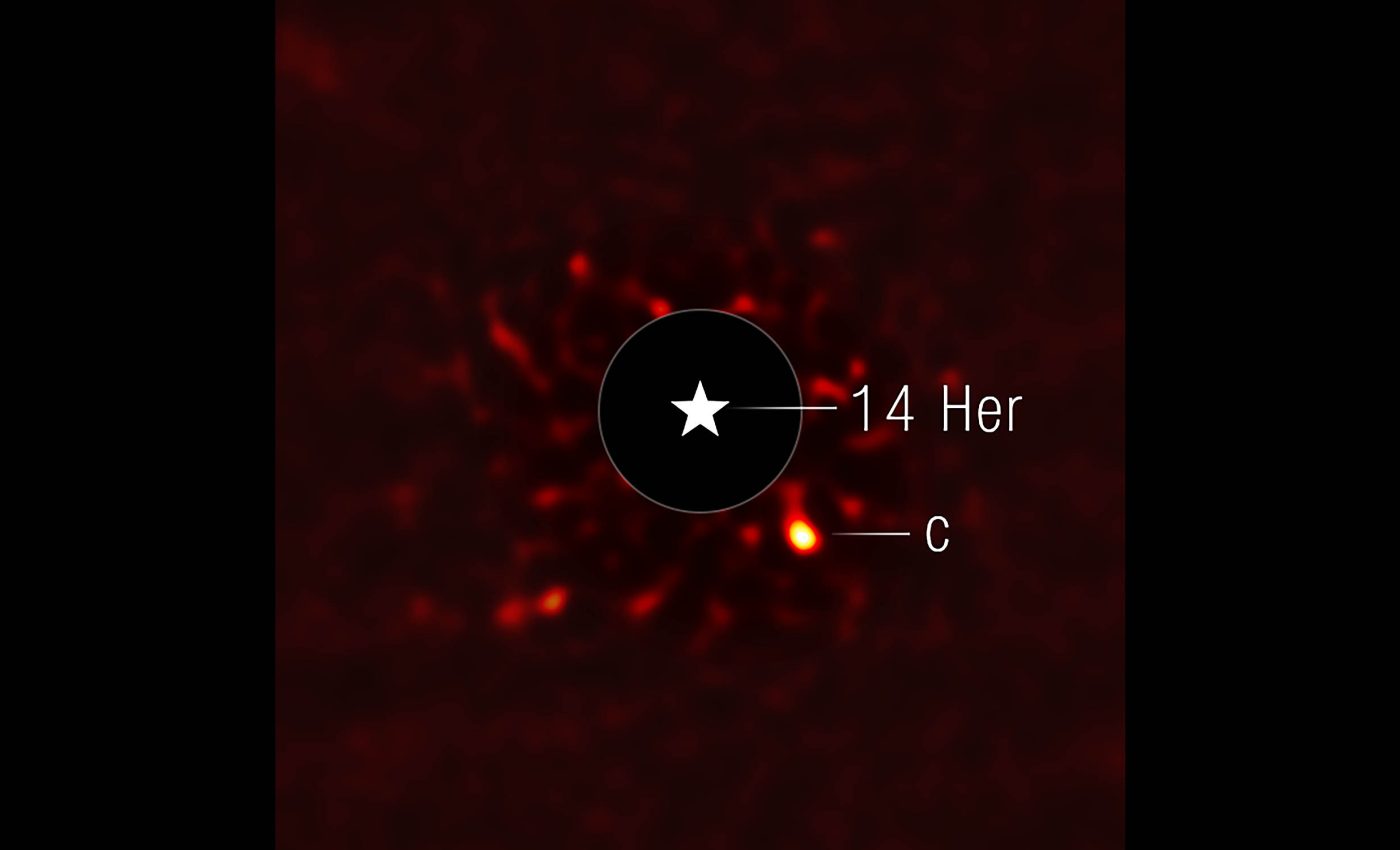
Webb Telescope reveals a chaotic, cold, and strange exoplanet
Astronomers have recently captured a rare and remarkable image of a giant exoplanet in an unusually tilted planetary system just 60 light-years away.
Using NASA’s James Webb Space Telescope, researchers have directly observed 14 Herculis c – one of the coldest planets ever imaged. This observation offers new insights into the evolution and behavior of planets in systems unlike our own.
The findings mark a significant leap forward in our ability to detect and study cold, older exoplanets thanks to Webb’s infrared sensitivity and imaging tools.
’14 Herculis c’ comes into focus
Only a small number of the nearly 6,000 known exoplanets have been directly imaged. Most of those tend to be blazing hot – often hundreds or even thousands of degrees Fahrenheit.
By contrast, 14 Herculis c is strikingly cold, with a temperature around 26 degrees Fahrenheit (or -3 degrees Celsius). The planet is also massive, estimated to weigh about seven times more than Jupiter.
William Balmer is co-first author of the new paper and a graduate student at Johns Hopkins University.
“The colder an exoplanet, the harder it is to image, so this is a totally new regime of study that Webb has unlocked with its extreme sensitivity in the infrared,” he said.
“We are now able to add to the catalog of not just hot, young exoplanets imaged, but older exoplanets that are far colder than we’ve directly seen before Webb.”
Webb’s Near-Infrared Camera (NIRCam) captured the faint glow of 14 Herculis c, a planet orbiting a star much like our Sun.
The central star, 14 Herculis, is slightly smaller and cooler than the Sun but otherwise quite similar. The system’s outer planet now offers a vivid window into planetary physics.
Planetary system in disarray
What makes this system even more fascinating is its unusual orbital layout. The two known planets, 14 Herculis b and 14 Herculis c, do not orbit in the same flat plane like the planets in our solar system.
Instead, their orbits are inclined about 40 degrees to each other, forming a tilted, crisscrossing dynamic around the star.
This extreme misalignment is the first of its kind ever seen in a directly imaged planetary system. The result is a gravitational tug-of-war as the two massive planets pull at each other while circling the star.
“The early evolution of our own solar system was dominated by the movement and pull of our own gas giants,” Balmer said.
“They threw around asteroids and rearranged other planets. Here, we are seeing the aftermath of a more violent planetary crime scene. It reminds us that something similar could have happened to our own solar system. The outcomes for small planets like Earth are often dictated by much larger forces.”
One theory suggests that an early collision ejected a third planet, leaving the remaining two in skewed orbits.
Webb reveals 14 Herculis c’s orbit
Webb’s image does more than show a planet – it also reveals hints about its atmosphere and orbit.
14 Herculis c orbits its star at a distance of about 1.4 billion miles, placing it between Saturn and Uranus in terms of location if it were in our solar system.
The planet’s orbit is highly elliptical – like a football – and closer to the star than earlier estimates suggested.
The researchers measured the planet’s brightness at a specific infrared wavelength – 4.4 microns – using Webb’s coronagraph.
Combined with known data about the planet’s mass and the system’s age, the team expected the planet to be brighter at that wavelength – but it wasn’t.
“If a planet of a certain mass formed 4 billion years ago, then cooled over time because it doesn’t have a source of energy keeping it warm, we can predict how hot it should be today,” said Daniella C. Bardalez Gagliuffi of Amherst College, co-first author of the paper with Balmer.
“Added information, like the perceived brightness in direct imaging, would in theory support this estimate of the planet’s temperature.”
Carbon clues in a cold atmosphere
But 14 Herculis c turned out to be dimmer than expected. Researchers argue that a process known as carbon disequilibrium chemistry – often observed in brown dwarfs – is the likely reason.
In these very cold atmospheres, carbon monoxide and carbon dioxide show up in places where methane should dominate.
The likely cause is rapid mixing that pushes warm molecules from deep within the planet into colder upper regions.
“This exoplanet is so cold, the best comparisons we have that are well-studied are the coldest brown dwarfs,” Bardalez Gagliuffi explained.
“In those objects we see carbon dioxide and carbon monoxide existing at temperatures where we should see methane.”
“This is explained by churning in the atmosphere. Molecules made at warmer temperatures in the lower atmosphere are brought to the cold, upper atmosphere very quickly.”
Beginning of a new chapter
Researchers hope that this early look at 14 Herculis c is just the beginning.
Webb’s tiny light holds data, but future spectroscopic observations will reveal even more. They could give scientists a much clearer picture of the planet’s atmospheric makeup.
That, in turn, could help explain not just how this strange system formed, but how planetary systems evolve when governed by giant forces and chaotic events.
By pushing the boundaries of what we can see, Webb has once again opened a door – to a cold and tilted world far from Earth, where the rules of planet-making seem just a little different.
The research was presented at the 246th meeting of the American Astronomical Society in Anchorage, Alaska.
The study has been accepted for publication in The Astrophysical Journal Letters.
—–
Like what you read? Subscribe to our newsletter for engaging articles, exclusive content, and the latest updates.
Check us out on EarthSnap, a free app brought to you by Eric Ralls and Earth.com.
—–













